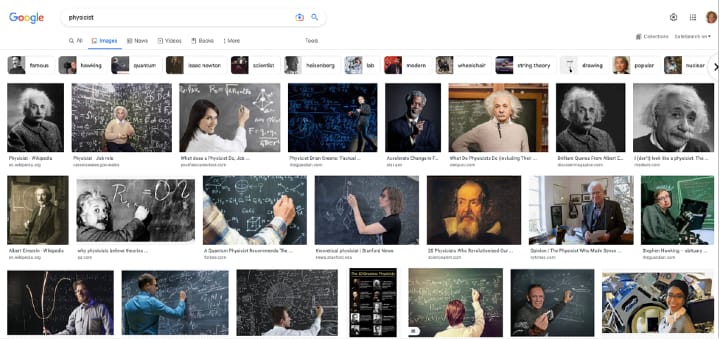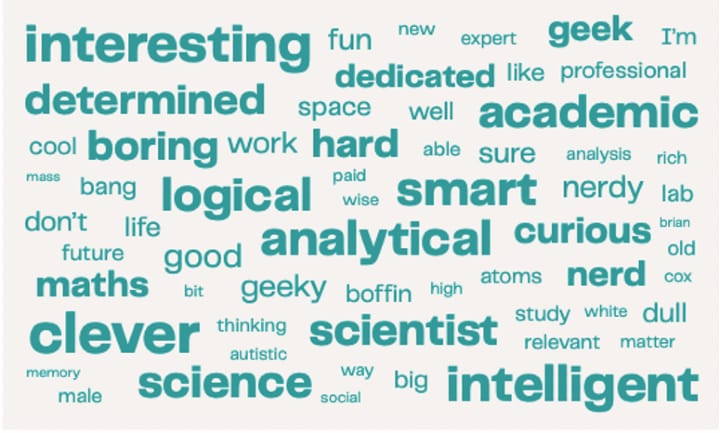If you close your eyes, what image comes to mind when you hear the word “physicist”?
The image below shows a recent Google image search for “physicist”. Does it confirm or shatter your own opinion?

To those of us working in physics this group of images is pretty disappointing: it reinforces the stereotypical image of physics as the preserve of ‘stale pale males’. Super-brainy boffins. And a subject which still uses chalkboards!
Parents and carers were asked to describe someone who does physics, and the next image shows a word cloud from the IOP Limit Less Report representing their responses:

What about gender imbalance in the classroom? The Aspires 2 project worked with children aged 10 to 18. Their research found that girls often did not feel “clever enough” to do physics, even though girls achieve similar grades to boys, and felt that teachers had lower expectations of them and were less interested in how they performed.
You can see a recording of a presentation about addressing gender issues in physics that we gave at the WomenEd Unconference in 2022, which is available on YouTube.
We know that the proportion of girls studying A-level physics in the UK has been stubbornly low for over 20 years at around 20%. And this under-representation follows through into the world of work where women make up only 22% of the STEM (Science, Technology, Engineering and Maths) workforce. There are also inequalities in social background, ethnicity, disability and neurodiversity.
Some might ask why this is a problem?
- To start with, the UK has a shortfall of STEM professionals – around 60,000 engineers per year are needed, for example. But it’s not just about UK plc.
- We need more scientists to meet global challenges: tackling climate heating, developing artificial intelligence, designing energy storage solutions.
- Teams solve problems better when they are more diverse.
- And anyway, we should ensure that this large proportion of the population are not put off physics for the wrong reasons, pressure from society’s stereotypes: perhaps working in physics would bring them the fulfilment they are currently being denied.
Planet Possibility
Addressing this as part of the solution is Planet Possibility, a consortium made up of universities (Birmingham and Southampton), charities (Future First and The Blair Project) and a business (All About Group). Together, these organisations boast vast experience in the areas of diversity, inclusion, engaging with young people, STEM, physics, careers and digital projects. Planet Possibility is funded by the Institute of Physics’ Challenge Fund to help deliver their strategic aim of improving the diversity of people doing physics in education, research and industry.
It is my pleasure, as someone who is passionate about physics (which I used to teach) and partnerships, to chair the consortium, to help draw out the synergies between these diverse partners.
Together, the consortium is:
- Providing a greater diversity of young people with access to physics specialists and role models – including traditionally under-represented groups, including girls;
- Providing greater support for physics teachers;
- Encouraging and developing talent into academic & technical physics-based careers.
Through a digital platform, the consortium is extending its reach with events, webinars, content, games, guides, jobs, work experience, mentoring and other tools and channels to help create a flourishing physics community.
We’d encourage everyone to register on the website – whether you are a student, teacher, parent, or you simply like what we are doing and want to tell others about it – to join the Planet Possibility community and stay updated about the consortium’s activities.
How can we help?
So, how can we help to encourage a wider cohort to consider physics beyond age 16? Here are my own top five suggestions, and I’ve added links to what we are doing at Planet Possibility to address each one:
1. Good quality teaching
The current challenge of recruitment in science teaching is severe. We know that the percentage of physics lessons delivered by subject specialists is low. Teachers delivering physics outside of their specialism are less likely to have access to alternative explanations or background stories about physics and are often less confident about delivering whole class practicals which are essential for bringing the subject to life and encouraging further study.
Planet Possibility is delivering fully-funded teacher workshops in physics topics and careers through specialist Physics Partners.
2. Whole school diversity policy
Tackling the low uptake of physics amongst girls or certain ethnic groups is only one angle. There are very few boys taking English A level, for example. A whole school approach is needed to address diversity issues: challenging unconscious bias in curriculum; ensuring appropriate and consistent language; sense-checking the images, examples, contexts and messages we are using in lessons and around the school.
Planet Possibility addresses diversity in physics in all its activities. Check out the TikTok videos from The Blair Project, for example, or the Lightyear Labs, fully-funded workshops for disabled children in special schools.
3. Access to role models
We can’t be what we can’t see! Careers role models open up a world of possibility for young people and can help to smash the nerdy male stereotype often associated with physics. It’s vital that students can see themselves as future physicists by meeting people like them, or seeing people like themselves represented around them.
Planet Possibility partner Future First offers schools workshops where they can meet physics role models, and has created a series of posters that can be printed for classrooms and corridors.
4. More opportunities to engage with physics outside the classroom
The GCSE science curriculum is jam-packed and as teachers rush through it there is little opportunity to reflect on the awesomeness of physics, to appreciate physics in the real world, and to do hands-on investigations. Students who can spend time outside lessons ‘tinkering’ with apparatus, discussing physics, asking questions are far more likely to engage with the subject more deeply and consider studying it further.
Planet Possibility partner The Blair Project can expand your capacity by running online physics clubs for your school or community youth group, engaging students in fun physics experiments. Their roving STEM Truck also provides an opportunity for young people – and their parents and carers – to learn about the role of physics in solving global challenges, through the on-board activities.
5. More awareness of routes into physics jobs
The traditional university degree, PhD and post-doc is still a route into physics, but many people take a different path with apprenticeships becoming very popular and the idea of earning while you learn becoming increasingly attractive. Many jobs involving physics are open to school-leavers too.
Planet Possibility features a range of careers and pathways on its website, and the Infinity Game is a fun way to explore the opportunities in physics that suit your personality style!
With a multi-dimensional approach, we can smash the outdated stereotypes around physics and, as teachers, parents and members of the wider community, do our bit to encourage more young people into exciting jobs for the future.
Please register at https://www.planetpossibility.co.uk/register and help us to build a thriving physics community!
